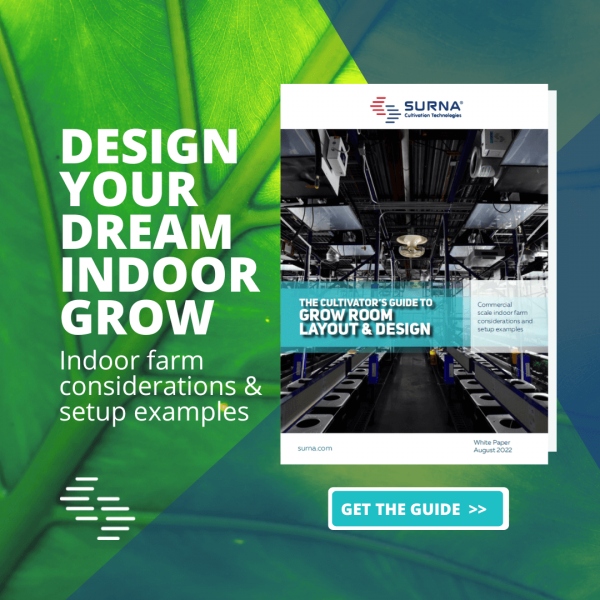It’s no secret that the cannabis industry has long been criticized for the amount of energy we use. No industry should be judged solely on consumption, but also for what it produces in exchange for that consumption. What is the economic benefit of that industry? After all, you wouldn’t gauge your car’s gas mileage based solely on the size of its tank.
This isn’t to say that we shouldn’t continuously strive to do better as it relates to energy efficiency. We absolutely, positively should, just as every industry should. Focusing on ways to do better is something Surna has always done, and in fact, improving energy efficiency in controlled environment cultivation was one of our founding principles. The fact is, improving energy efficiencies in cultivation has a lot of upsides, with very little downside. Energy use is in the top 3 recurring monthly expenses for most cultivators, and many would put it at the very top of their list. Focusing on improving efficiencies isn’t just the right thing to do–it can help our own bottom line as business owners in a big way.
With that in mind, we thought we’d share some of our top tips for improving energy efficiency in your grow.
1. UNDERSTAND YOUR MECHANICAL (HVAC) SYSTEM
Many people don’t realize that in most grows, the HVAC system actually uses more energy than cultivation lighting. (Mechanical design also impacts every other facet of your facility, plant health, and financial performance, but those are subjects for another day). The “ideal” HVAC design for your facility is going to depend on a number of variables including geographic region, climate parameters, irrigation methods, and lighting selections, to name a few. Typical efficiency metrics (EER/SEER) are based on comfort cooling applications and don’t always apply in cultivation facilities. Make sure when designing the HVAC system that your mechanical engineer understands the unique requirements of cultivation facilities and how they use energy and is able to clearly articulate to you the way the various systems work and their pros and cons as they relate to energy efficiency and operation in your specific facility.
2. UNDERSTAND LIGHTING TECHNOLOGIES
This rule is three-fold. First, take the time to study and understand the different lighting technologies available to you, and what their efficiencies mean. Micromoles per joule is a common metric in lighting technology, but without relevant spectrum data, it’s a meaningless number. Understanding lighting means understanding how much of the light produced by that energy consumption is actually useful to your plant, and how much of it is wasted.
Second, learn about the impact radiant heat has on vapor pressure deficit (VPD), and how to manage your climate around the lighting technology you select.
And third, understand how the various technologies will impact the SOP’s in your facility. Lighting selection is a science in and of itself. Understanding that science puts you in a position to make the most efficient decision for your facility.
3. BE MILITANT WITH YOUR MAINTENANCE PROGRAM
Maintain all equipment in your facility regularly and in accordance with manufacturers’ recommendations. Failure to maintain equipment can cause it to struggle, running longer or using more power while it’s in operation. (It can also lead to premature failure). Essentially, as with your car, lawn mower, or furnace, neglected equipment are less energy efficient. This is especially true of HVAC systems but extends to pumps, nutrient chillers, fans, and all manner of other equipment you may use in your facility.
4. UNDERSTAND YOUR UTILITY
This is less about using less energy and more about when and how to use it. Keep in mind, however, it will still have a direct impact on your bottom line. Most utilities will have an up-charge of some kind related to peak energy use—the most energy used at any point during the day (even if it’s just for a few seconds). You will also likely see a higher cost of power at certain times of the day—peak demand. Understanding what these up-charges look like can help you manage lighting schedules (and customize HVAC design accordingly). Altering these schedules provides the potential to substantially reduce your monthly utility bill. For more information on this, read our blog, Flip Your Grow.
5. FOCUS ON YIELDS (ALWAYS!)
The energy efficiency of individual cultivators should be judged not just by what they consume, but how much they produce in exchange for that consumption. Cultivators should do everything possible to maximize yields and replicate those processes in each new facility. This sounds like a no-brainer, but there is a surprising amount of complacency among some cultivators and yields. Continuous improvement means tightly controlling every single parameter in the grow—from temperature and humidity to pruning to irrigation schedules—to ensure repeatability once a yield recipe is developed. Increasing grams per kWh translates to reducing dollars per gram which is a win/win!
6. DON’T FEAR CHANGE
“That’s the way we’ve always done it” is the mantra of too many members of our industry. This way of thinking will ultimately lead to those cultivators falling behind. Utilization of a test room gives cultivators the opportunity to experiment with climate, methodologies, and new technologies without risking a production crop.
To speak to someone directly, contact us.

